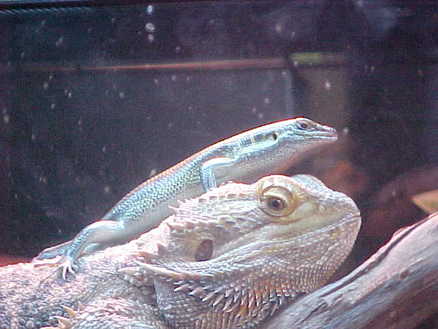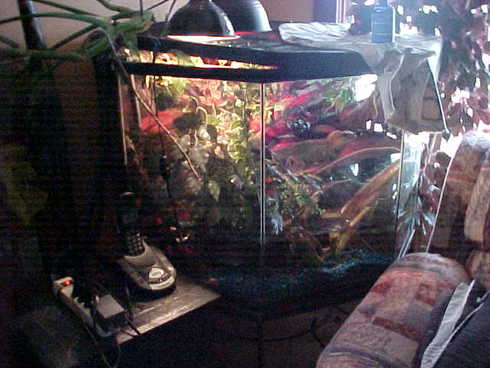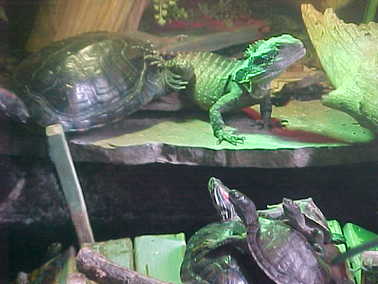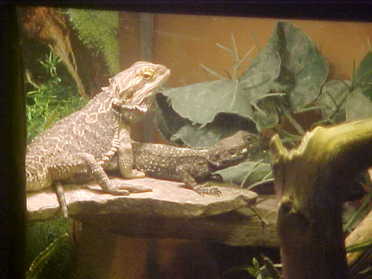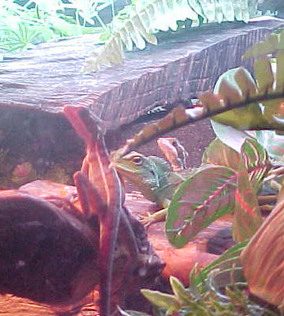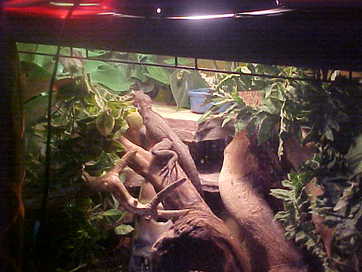PLEASE NOTE
The information on the BambooZoo site is as much as 10 years old and in the hobby much has been learned. Though, I believe there is merit in keeping the site open. There are many controversial issues presented in these pages. Please view BambooZoo as a starting point in your research.
These beings are as complicated as we are and deserve more than a basic 5 paragraph care sheet to maintain their health and well being.
My passion has changed. This is where I am today. Change the World.
Loading
LET'S TALK COHABITATION OF SPECIES OF REPTILE AND AMPHIBIANS
aka BambooZoo in the forums
MIXING
Source: http://reptileuk.21.forumer.com/view...9de11a704d1d47
Mixing species of reptiles and amphibians is always a controversial subject. Some people may have luck with it, but for the majority of keepers, it is not somthing that is advised and it has the potential to go very horribly wrong.
Very often, people post threads asking about whether they can mix 'this' with 'that', and so here I hope to clarify some of the reasons mixing species does not normally work. Many pet shops will mix species together to save space, and even recommend to customers that they are fine together, even when they most likely will not be for the long term. This post is not intended to be an attack on anyone who does mix species, and nor is it supposed to lay down ‘the rules’ that you must follow. It is simply information about the very important considerations that must be made when thinking about mixing species, and an attempt to help people wondering why people say it shouldn’t be done.
I have tried to base the majority of this information on science, and not just the hear-say and gossip that inevitably gets passed around as fact. Some people will have success with mixing species, and there are very rare exceptions to the general rules where 2 species are relatively compatible, but before you attempt mixing species, you must 1st be armed with as much knowledge about the problems as possible.
* Conditions.
As herptiles are ectotherms (cannot regulate their internal body conditions) living conditions are even more important than in other taxa. The species available in the pet trade come from a wide range of countries and environments which need to be simulated in their captive housing. This is the 1st consideration you must make when thinking of mixing species. How will you provide both species with its optimum conditions in the same vivarium? Even species that originate from the same country will need different conditions as in the wild they inhabit niches that are individual to them and provide them with the perfect conditions. For example, The Whites Tree frog (Litorea caerulea) is found in Australia, as is the Bearded Dragon (Pogona vitticeps). However, these 2 species need completely different conditions, and a Whites tree frog could certainly not survive in a set up designed for Bearded dragon. Even species that come from the same type of habitat, such as the whites tree frog and Red-eyed tree frog will require slightly different conditions to thrive, even though they both come from humid rainforest type environments. Without having a zoo-sized exhibit (beyond the means of most private keepers) it is impossible to provide both species with optimum conditions, and so 1 or both species will have to be compromised. This may not affect them in the short term, but as with all these issues, it may impact the long-term health of the animals.
* Fighting and stress.
Many species are highly territorial, and as most would not encounter one another in a wild situation, there is always the risk of fighting between vivarium occupants. This is an issue with same species groups, let alone mixed species. When there is a size difference between the species, the smaller species may often be looked upon as a prey item, and the larger will attempt to eat the smaller.
Reptiles and amphibians are very susceptible to illness from stress. Lactic acid builds up in the system as the stressed animal respires anaerobically, and can often reach fatal levels. When mixing species, the animals are kept in much closer proximity than they would ever normally be in the wild and moreover, they cannot escape. Over time this will cause great stress to the animals. Most people will agree that they want to keep their animals as healthy and naturally as possible, and in the wild they would not be forced to spend time close to another species in the way a vivarium does.
* Competition
Different species have different habits and methods of catching prey and feeding, and these often conflict causing competition issues in a mixed vivarium. I will use species I know well to demonstrate my point here. The Whites tree frog will wait very patiently, still and silent until the exact moment to strike, and then it jumps onto its prey. This can be a few minutes even! The Crested gecko on the other hand is much more rash in its hunting methods, and will pounce on a prey item with seemingly little forethought. If these 2 species were kept in the same enclosure, the geckos hunting method would likely cause the patient frog to be out-competed as it’s silent and still approach would be disrupted. Even issues other than food may be competed over, for example, who gets the best basking site? Who gets to use the ‘best’ hide?
* The Chemistry.
All animal species in the world carry unique bacteria and protozoans that aid different processes to us, and in return they cause us no harm and we allow them to use the body of its host as protection and habitat. This process is called symbiosis. When 2 species come into close contact (as would happen in a vivarium) the symbionts from 1 species will get passed onto the other, and this may cause the 2nd species to become ill. What is harmless and healthy for 1 species is not for another. With WC animals, these problems are exacerbated, as you not only have to deal with symbionts, but parasites and illnesses that the other species will not be resistant to as they would not have been naturally exposed to them.
With amphibians, the problems of chemistry are all the more severe, as they are particularly sensitive to external environment due to their semi-permeable skin. Even their own ammonia can kill them if water is not changed frequently enough, so add to that the waste products of another species and you have even worse problems. All amphibians produce toxic secretions from their skin, and while they may be so weak that they do not pose a health issue to us, another species, which is going to come into contact with the toxins in their environment, in their water supply, and potentially on their food, this may cause a serious health issue. Fire-bellied toads are one of the most toxic commonly kept amphibians, and I often get asked if they can be mixed with other species!
* Habits.
When considering mixing species, thought must be given to how the different habits of the species will conflict. Diurnal species such as Anoles may conflict with nocturnal species (i.e. most geckos) as whilst one is sleeping, the other is active and may disturb the other. This is likely to cause stress.
As I said at the beginning of this post, some people do have ‘success’ with mixing species. However, a lot of these issues will not become apparent in the short term. It may be months, even years before the extent of the problems takes effect and as reptiles have such different mechanisms for displaying ill health than mammals, we may not spot the signs until it is too late. Before you even contemplate mixing species, you need to have kept each species separately, for long enough that you can know the ins and outs of each individuals eating habits, behaviours, appearance… so that if something is wrong, you can spot it. Mixing species should NOT be done for the conservation of space. This is not a good reason to mix, as the size of enclosure that a mixed exhibit will need is far bigger than the vivariums each species would need separately. Certain exceptions apply, as in all fields, but this should not be taken lightly either as it is not always successful. Whites tree frogs may be kept successfully with Whites lipped tree frogs (same genus, Litorea) and likewise, Crested geckos have been kept with Mossy geckos (same genus again, Rhacodactylus). However, these are exceptions. Crested geckos may not be kept with any other member of their family such as the Gargoyle gecko or Leachianus, and so it is not simply a matter of how related 2 species are.
Bearded dragons are completely solitary animals and should not be kept together, and if are housed together you should have a second tank ready just incase.
Source: http://reptileuk.21.forumer.com/view...9de11a704d1d47
why not to cohabitate reptiles: http://www.cornsnakes.com/forums/showthread.php?t=31192
The above is one of the most informative and open statements I have seen on the subject.
THE FOLLOWING AREAS OF THE TOPIC OF COHABITATION ARE MY EXPERIENCES. SHOULD I HAVE DONE WHAT I HAVE, LIKELY NOT. THERE IS ADVICE AND INSIGHT I CAN PROVIDE AFTER WORKING THIS WAY FOR 14 YEARS.
I am likely the most liberal keeper you may ever meet. My husbandry very different from your own or any you have seen. Much of what has been attempted here has never been discussed elsewhere. My education came from species specific books. I don't think I ever read about not mixing species. I was sold my first cohabitation environment less than 4 months into the hobby. It was a 3 foot hexigon with 2 adult water dragons, a red eared slider (6 year old female) and a few fish and snails. A third would be that I had no reptile keeping associates. By the time I was acquainted with the opinions in the hobby I had been practicing cohabitation and going the natural directions of keeping for 6 years. I have made errors in species choices and matches. Not everything has gone according to plan and when it does not, I adjust quickly. There are always spare vivs here. All my reptiles are on the main floor and in our living space. I am home 24/7 and I pass these spaces constantly.
I follow a few basic rules when considering an environment and who will share.
FOOD
The availability of food was exceptionally important in these co habs. I never fed anyone anything larger than worms so they had no experience with catching larger prey. In some set ups there were multiple feeding stations, in others I would refill the bowl after the most aggressive feeder had eaten. I went to natural living soils a few years ago and many of the lizards have learned to supplement their diets with the available vivarium cleaning crew. My animals tended to be a little heavy. I would overfeed instead of risking under feeding. I worked very hard at making sure we did not have to go through feeder shortages.
I follow a few basic rules when considering an environment and who will share.
FOOD
The availability of food was exceptionally important in these co habs. I never fed anyone anything larger than worms so they had no experience with catching larger prey. In some set ups there were multiple feeding stations, in others I would refill the bowl after the most aggressive feeder had eaten. I went to natural living soils a few years ago and many of the lizards have learned to supplement their diets with the available vivarium cleaning crew. My animals tended to be a little heavy. I would overfeed instead of risking under feeding. I worked very hard at making sure we did not have to go through feeder shortages.
ELECTROLYTES
There is one supplement that I have worked with consistantly. I use electrolytes pro actively. I use them when doing an environment change. I use them if someone is being fussy about eating for a few days. I use them to work out diet changes and gain cooperation. I use them when introducing species. I use them when I see a depressed state. I use them for illness and accident and tail loses. I have used them for as long as 6 weeks straight. I have used them just once with results. A basic electrolyte rebalances their system. It eliminates hunger strikes. It strengthens immunity and enables them to fight off small issues on their own.
Are their environmental needs similar? Species will have an ability to adapt to a range of humidity, temperature and more as within a natural range there will be a variety of conditions. A wall walking gecko does not take the same space as a terrestrial lizard. Will I be able to address security issues. What are their food preferences. When are their most active hours. Being opposites in many ways can be beneficial.
I have learned that if you can address their issue of feeling secure you will be able to maintain a healthy lizard. I rearrange an environment when placing someone new in to it. This shakes up the former inhabitants a little and when the new kid shows up they just react with curiousity and an attitude of if you leave me alone....I will leave you alone. Or a "Huh. You live here too. For a few days they are quite observant and don't like to be approached too closely. Each learns the boundries of the other resident.
There is nothing we do in captivity that can compare with what life would be in the wild. Many species choose solitude in the wild for protection of resources. Without the neccessity for survival of the fittest and consistant food battles there is no reason for territorial issues. From the variety of food sources, the glutinous periods vs the hardship phases, to attempting to duplicate mother nature we are a poor substitute. We are no where close to being able to provide what they would be experiencing. Their adaptability into our own living conditions is incredible. Optimal captive conditions would include the wide variety of experiences in seasonal changes, food choices, temperature and the list continues.
Even our living soils contain protazoa and lower life forms that would not be experienced in their wild environments and should consequently cause issues when introduced to our reptiles for the first time historically in the existance of the species. Keepers are not experiencing that phenomena(sp). Nor have there been problems with the many bugs I gather from the yard for the purpose of variety. Passing disease is possible. It has not happened here that I have been able to note.
There is one supplement that I have worked with consistantly. I use electrolytes pro actively. I use them when doing an environment change. I use them if someone is being fussy about eating for a few days. I use them to work out diet changes and gain cooperation. I use them when introducing species. I use them when I see a depressed state. I use them for illness and accident and tail loses. I have used them for as long as 6 weeks straight. I have used them just once with results. A basic electrolyte rebalances their system. It eliminates hunger strikes. It strengthens immunity and enables them to fight off small issues on their own.
HABITAT SIMILARITIES
Are their environmental needs similar? Species will have an ability to adapt to a range of humidity, temperature and more as within a natural range there will be a variety of conditions. A wall walking gecko does not take the same space as a terrestrial lizard. Will I be able to address security issues. What are their food preferences. When are their most active hours. Being opposites in many ways can be beneficial.
I have learned that if you can address their issue of feeling secure you will be able to maintain a healthy lizard. I rearrange an environment when placing someone new in to it. This shakes up the former inhabitants a little and when the new kid shows up they just react with curiousity and an attitude of if you leave me alone....I will leave you alone. Or a "Huh. You live here too. For a few days they are quite observant and don't like to be approached too closely. Each learns the boundries of the other resident.
There is nothing we do in captivity that can compare with what life would be in the wild. Many species choose solitude in the wild for protection of resources. Without the neccessity for survival of the fittest and consistant food battles there is no reason for territorial issues. From the variety of food sources, the glutinous periods vs the hardship phases, to attempting to duplicate mother nature we are a poor substitute. We are no where close to being able to provide what they would be experiencing. Their adaptability into our own living conditions is incredible. Optimal captive conditions would include the wide variety of experiences in seasonal changes, food choices, temperature and the list continues.
Even our living soils contain protazoa and lower life forms that would not be experienced in their wild environments and should consequently cause issues when introduced to our reptiles for the first time historically in the existance of the species. Keepers are not experiencing that phenomena(sp). Nor have there been problems with the many bugs I gather from the yard for the purpose of variety. Passing disease is possible. It has not happened here that I have been able to note.
This is one of the extremes in housing. This hexagon is where my Water Dragons lived. This hexagon was sold to me with the male and female. I raised 3 dragons in here, 2 of which were large males. And this was the life time area for B&E and the female. This worked well for B&E due to his limitations.
The water dragon above was raised in the hexagon for approximately 1.5 years and many others passed through and were eventually put into other environments. My Green Water Dragons lived successfully with all but the Green Basilisks and he was the agressor. Situations are always changing around here and upgrading might mean redoing 5 or 6 environments as each gets a little more than they had previously. I believe more important to the success of this tank that was shared with a painted turtle and fish and snails, was how it had been set up, the water area size, 35 to 40 gallons, the sound of water was closest to their ear. 5 differing levels and tons of cover. Basking did not necessarily mean being front and center.
This is Bent and the larger Star Agama. These 2 resided well together though their settling time was a little long. Bent came here with a lack of growth problem and remained the size you see in the photo. The Star is very active in comparison and they needed to sort out some trust issues. During this time I added electrolytes to their water every 3 days. Both were eating well during the process. The Bearded ate first. I would refill the bowl for the Agama.
This is a life match between a female Brown Basilisk and the Green Water Dragon. The calm demeanor of the Water Dragon helped this skittish girl to relax.
They find security in each other. I have had many more issues trying to house a male and female of the same species in these spaces than differing ones.
I find the reptile stays more engaged in the environment and more natural behaviours are seen. There are decisions to be made. Hunger strikes are kept to a minimum when they are aware another animal will take the resources.
A calm species will help to keep a species that is known for flightiness stay grounded. They learn to take their flight response cues from the other and panic less.
Often times we see sentries posted. One taking a rest while the other is ensuring safety. We see this with two of the same species, beardeds are a good example. This is also true of differing species.
I also believe that the sound of the frogs being close are another calming influence. If the frogs and toads are croaking then all is well in the world.
I find the reptile stays more engaged in the environment and more natural behaviours are seen. There are decisions to be made. Hunger strikes are kept to a minimum when they are aware another animal will take the resources.
A calm species will help to keep a species that is known for flightiness stay grounded. They learn to take their flight response cues from the other and panic less.
Often times we see sentries posted. One taking a rest while the other is ensuring safety. We see this with two of the same species, beardeds are a good example. This is also true of differing species.
I also believe that the sound of the frogs being close are another calming influence. If the frogs and toads are croaking then all is well in the world.
Part of the equation, is in working as naturally as possible, providing 30 places to hide. I have never seen a lizard with a choice between a natural space or an industry made hide use the hid. Differing levels and exposure to heat and light. (I don't do real plants, too fussy for me. Though I will add them for temporary use.)
Ensuring that you know the reptile well, as each is an individual, and know what is healthy behaviour and habits. Knowing what the signs are for stress, what diseases can be brought on from a lowered immunity and act upon the first signal......not the 5th or 6th. You must be willing to give up your time and have extra resources available at all times.
The Anoles lived well with others. My veiled chameleon also did well in cohabs and would defend only 1 ficus tree as his territory.
A WORD ON FAILURES
The male Green Basilisk was mentioned above. He was territorial and became more aggressive as the other species preferred to make peaceful moves and retreat. The Australian became very aggressive with cagemates and when in a free roam situation ate an escaped berber skink, whole. My frogs of differing species tended to last 2 to 4 years and then I would somehow manage to screw up. A water dragon ate one and would eat clawed frogs. My fire bellies were eventually eaten by a leopard frog. The leopard frog suffered no ill consequences and is the only frog here today.
The uro would not live in a community setting. My Mountain Horned Dragon was too sensitive.
BEHAVIOUR AND PATHWAYS
Ensuring that you know the reptile well, as each is an individual, and know what is healthy behaviour and habits. Knowing what the signs are for stress, what diseases can be brought on from a lowered immunity and act upon the first signal......not the 5th or 6th. You must be willing to give up your time and have extra resources available at all times.
The Anoles lived well with others. My veiled chameleon also did well in cohabs and would defend only 1 ficus tree as his territory.
A WORD ON FAILURES
The male Green Basilisk was mentioned above. He was territorial and became more aggressive as the other species preferred to make peaceful moves and retreat. The Australian became very aggressive with cagemates and when in a free roam situation ate an escaped berber skink, whole. My frogs of differing species tended to last 2 to 4 years and then I would somehow manage to screw up. A water dragon ate one and would eat clawed frogs. My fire bellies were eventually eaten by a leopard frog. The leopard frog suffered no ill consequences and is the only frog here today.
The uro would not live in a community setting. My Mountain Horned Dragon was too sensitive.
BEHAVIOUR AND PATHWAYS
PAT BARRY
aka BAMBOOZOO
148 GALLON Multiple species
STAR AGAMA AND LEOPARD GECKOS HABITAT
STAR AGAMA AND BEARDED DRAGON
GIANT DAY & WHITES TREE ENVIRONMENT
COMMUNITY VIVARIUMS VIDEOS
A SHORT COMPILATION OF ZOO COHABITATION EXIBITS
STAR AGAMA AND LEOPARD GECKOS HABITAT
STAR AGAMA AND BEARDED DRAGON
GIANT DAY & WHITES TREE ENVIRONMENT
COMMUNITY VIVARIUMS VIDEOS
A SHORT COMPILATION OF ZOO COHABITATION EXIBITS
A heartfelt thank you to all those participating in building this site.
HOME
Share |

